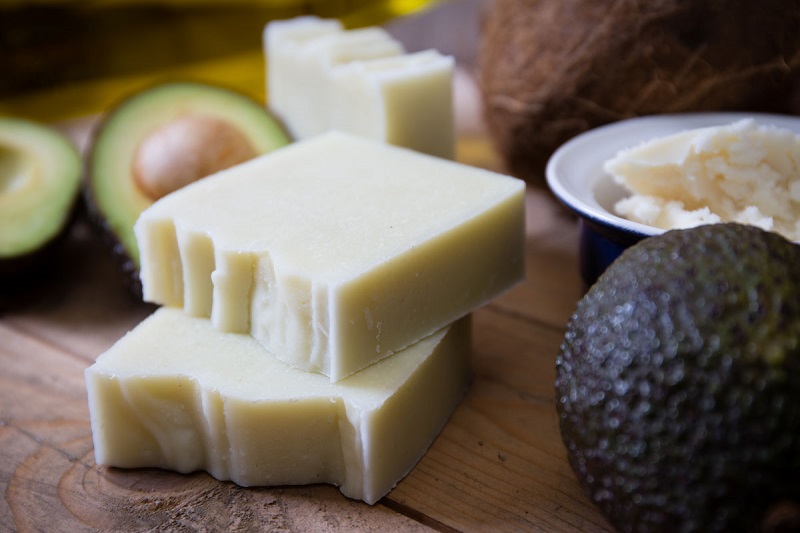The fats and oils used in soap can be derived from either animal or vegetable fat. For example, sodium tallowate is a common soap-making ingredient, derived from rendered beef fat; tallow, bacon grease, lard, or any other type of animal fat can also be used.
Palm, corn, canola, and olive are all common ingredients for vegetable- based soaps. Typically, soaps made from vegetable oils are softer than those made with animal fat.
The most useful oils for soap-making are fixed oils – oils that can be raised to a high temperature without evaporating. This is not the same with Essential oils; as they typically have to be added at trace, because they tend to evaporate at a much lower temperature. Fixed oils include a variety of base oils, such as olive, palm and coconut oils.
However, there are two types of fats used for soap-making: saturated fats and unsaturated fats. Saturated fats make a hard soap. They commonly come in a solid form and must be melted prior to use; cocoa and shea butters are good examples of saturated fats.
Unsaturated fats, like some vegetable oils, come in a liquid form, and are commonly used to make liquid soap. To use these fats to make bar soap, they must be mixed with saturated fat; the more saturated fat you use, the harder the bar will be.
Fragrances And Other Additives
There are two types of scent oils: essential oils and fragrance oils. Fragrance oils are man-made and contain alcohol, so they are typically avoided; the alcohol and other chemicals in the oil may be drying or irritating to the skin, and cause unforeseen problems with the saponification process, or ruin the soap mixture altogether.
Essential oils are more costly, and sometimes more difficult to find; however, a smaller amount is required (usually only a drop or two) and they retain their scent better because they are undiluted. Research oils thoroughly before use; some can be irritating to skin, or even toxic. Also, different amounts are required for different oils, because some will overpower others if the same amount is used for all.
Avoid potpourri, candle scent oils and other strong, commercially-made fragrances, as they often contain harsh chemicals that can be irritating to the skin as well. Whole or crushed herbs can also be used, but they will not give their full benefits in a first batch of soap; if you use herbs, the best thing to do is to rebatch the soap later, to extract the full benefit from the herbs.
Colorants
Colorants can be purchased at a soap-making supply store. There are also various other natural ingredients that you can use to color soap. For example, powdered clay can be used to color your soap pink, pastel green, or beige; it is also a great additive for soap intended for oily or acne-prone skin, because it will absorb oil from the skin without drying the skin excessively, or damaging it. Cocoa powder or tea can be used to turn the soap a deep, rich brown (cocoa powder will, of course, make the soap smell like chocolate). Paprika will give your soap a deep reddish color, and yellow can be achieved by using saffron, annatto seeds, or turmeric. A deep, rich purple can be achieved using ratanjot.
Lye
There are some precautions that must be taken when working with lye. After opening the lye, make sure that the lid is tightly closed.
Lye has deliquescent properties, meaning that it has a tendency to melt or dissolve when it comes into contact with open air; it is also hygroscopic, meaning that it will absorb moisture from the air, and will form lumps in the powder. Either of these tendencies can render the lye unusable if it comes into contact with open air for long, so the container in which it is stored must always be sealed.
Lye is also dangerous if spilled. Use protective equipment and clothing, to prevent skin burning or irritation from a lye spill. Be sure to keep the lye away from children and pets – it can be fatal if swallowed. Work in a well-ventilated area, as lye releases toxic fumes when mixed with water; mix outdoors, or wear a protective respiratory mask, if possible. Vinegar can help to neutralize the lye mixture if it spills, so keep a bottle close at hand while working with lye. If the lye spills on any surface – skin, furniture, etc. – wash the affected area with vinegar, then soap and water, and rinse it clean.
Be sure to purchase lye that is labeled for soap-making. There are other lye products that are similarly packaged, such as food-grade lye, or 100% lye drain opener. The food-grade lye is not strong enough to make soap with, and the lye drain opener is, of course, much too harsh, and contains many other chemicals which you would not want on your skin.
There are some materials which should never come into contact with lye. Do not use any container, or heating vessel, made of aluminum, brass, bronze, chromium, iron, magnesium, zinc, or anything coated with Teflon. If the lye comes into contact with any of these materials, it will react with them to produce hydrogen gas, which is extremely flammable, and explosive. Also, the lye should never come into contact with sugar; this mixture will produce poisonous carbon monoxide gas.
Materials that are suitable for contact with lye, at room temperature, are: high-density polyethylene (HDPE), polypropylene (PP), polyvinyl chloride (PVC), silicon rubber, stainless steel, glass, and porcelain. Stainless steel is the best material for heating vessels, as it can withstand elevated temperatures. Plastics may soften at higher temperatures, so unless the plastic has already been tested, glass or stainless steel are the best materials formixing containers. Because lye is a corrosive material, any amount of it that you order or purchase will most likely come with a material safety data sheet, or MSDS.
